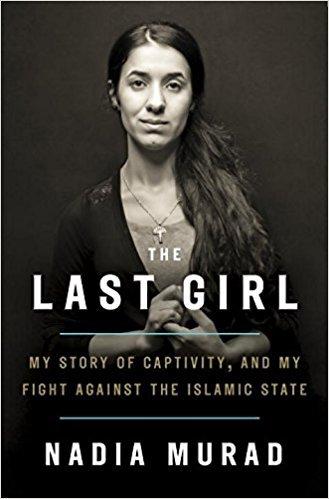This isn’t really a review because this is the kind of book that’s nearly impossible to review. It was impressive, inspiring, devastating, and informative. Nadia Murad grew up in the village of Kocho in Northern Iraq, in a small community of Yazidi, an ancient religion and ethnic minority. She describes the persecution of the Yazidi during her childhood, and then the rise of the Islamic State (ISIS). In 2014, ISIS militants occupied Kojo and rounded up all of its residents, with the intention of eliminating the Yazidi. The men were killed, young boys were taken and raised as militants, and the young women were sold into sexual slavery.

Nadia was able to escape, and eventually she was able to tell her story. She struggled with how much to tell the world about what was intensely private and painful. But she also realized that her enslavement was terrorism and genocide, and the world needed to know. She became a United Nations Goodwill Ambassador, wrote her story, and won the Nobel Peace Prize in 2018.
I go back and forth between thinking about how amazing she is, and then thinking how ordinary she is. And by that I mean, she’s a woman who grew up thinking about school and friends and family. She collected glamorous wedding photos and dreamed of someday owning a salon. She expected her life to be similar to that of her mother’s and the other women in her village.
And after she’s captured, it wasn’t that she was the most daring, or fought the hardest. She survived repeated torture and rape, and she’s representative of the many women that were abducted and forced into slavery. She’s exceptional, but she’s not. Sadly, she’s one of many.
She draws our attention away from the explicit details of her sexual enslavement, not because she’s hiding, but because it’s not where our focus should be. She simply says “I was raped” again and again. Rape is a word people often don’t want to use, but I think in this book Murad has made a conscious choice. She spends more time on the psychological trauma she endures. She’s told that she’s a possession, that any effort to fight back will only result in greater punishment (and it does). She’s told her community will never accept her again. If she escapes her photo will be posted at every checkpoint. She isn’t being held by one man, but by an entire network of militants.
One of the more devastating moments in the book happens when she meets the mother of one of her captors. She expects the woman to be horrified at her situation, but instead the woman says “now that you’ve converted you will be so much happier”. At this moment, Nadia realizes that if this woman, a mother, doesn’t think there is anything wrong with her captivity and rape, there may not be anyone in the entire city of Mosul who will support her if she flees. It’s amazing to me that she has the courage even to try.
Since leaving Kocho, I had begged for death, I had willed Salman to kill me or asked God to let me die or refused to eat or drink in the hopes I would fade away. I had thought many times that the man who raped and beat me would kill me. But death had never come. In the checkpoint bathroom, I began to cry. For the first time since I left Kocho, I thought I actually might die. And I also knew for sure that I didn’t want to.
Nadia Murad, The Last Girl
As with any memoir, there were times her story felt a little slow, as in her earlier years, and there were times it was so upsetting I had to put it down and walk away for a while. And then times when I couldn’t put it down, despite knowing of course that she survives to write this book. Not all memoirs, no matter how inspiring, make for great reads, but this one did. I think it’s because Murad brings so much honesty and raw emotion to her words. She never makes herself out as any kind of hero, in fact she focuses on the people she couldn’t help, and those who risked their own safety to help her.
I read this book as part of the Reading Nonfiction Challenge, the TBR Pile Challenge, and the Backlist Challenge. It’s been on my TBR list for a while but it’s the kind of book that’s intimidating to pick up. It’s also part of my effort to read more about other countries, particularly by authors who are from those countries.

